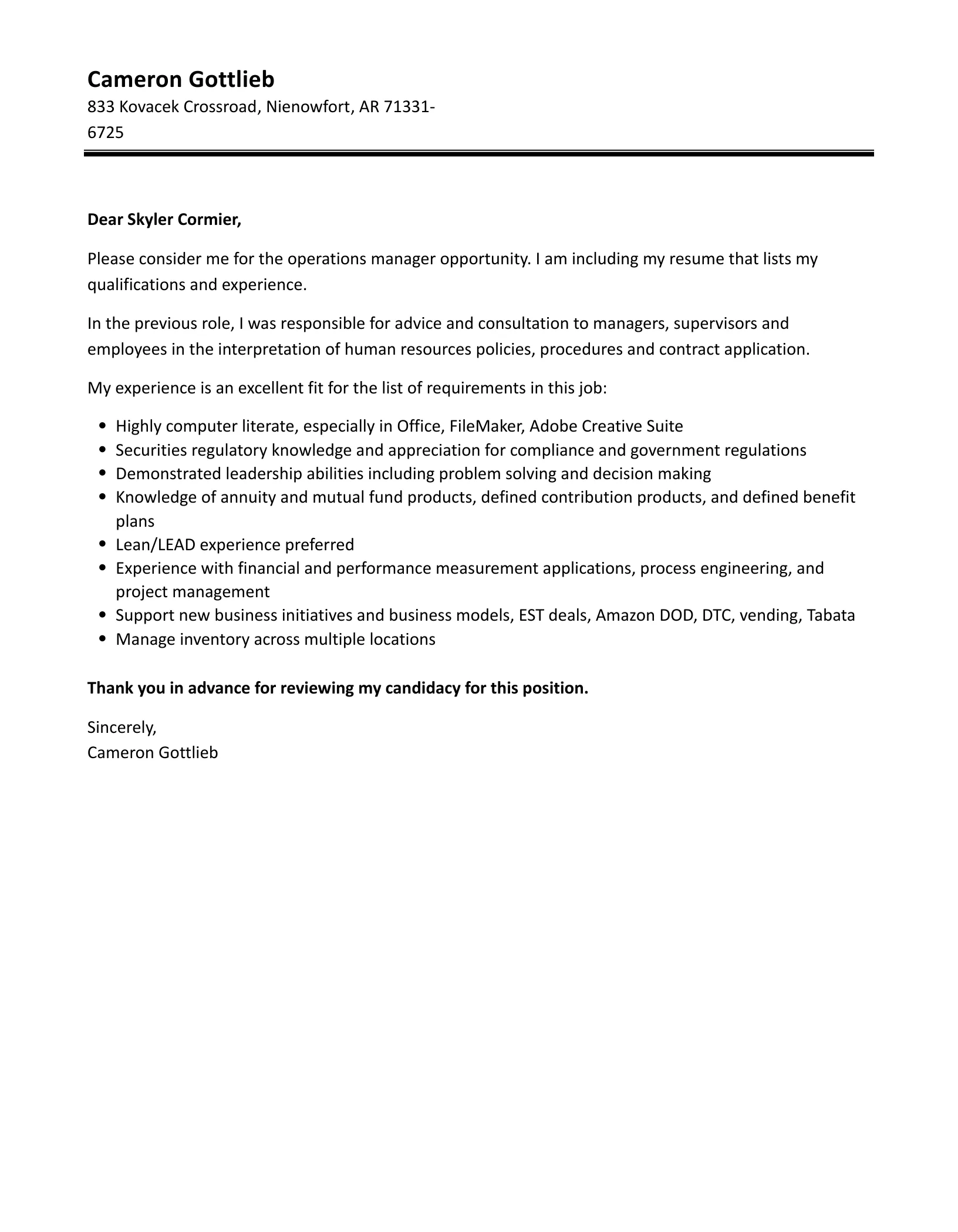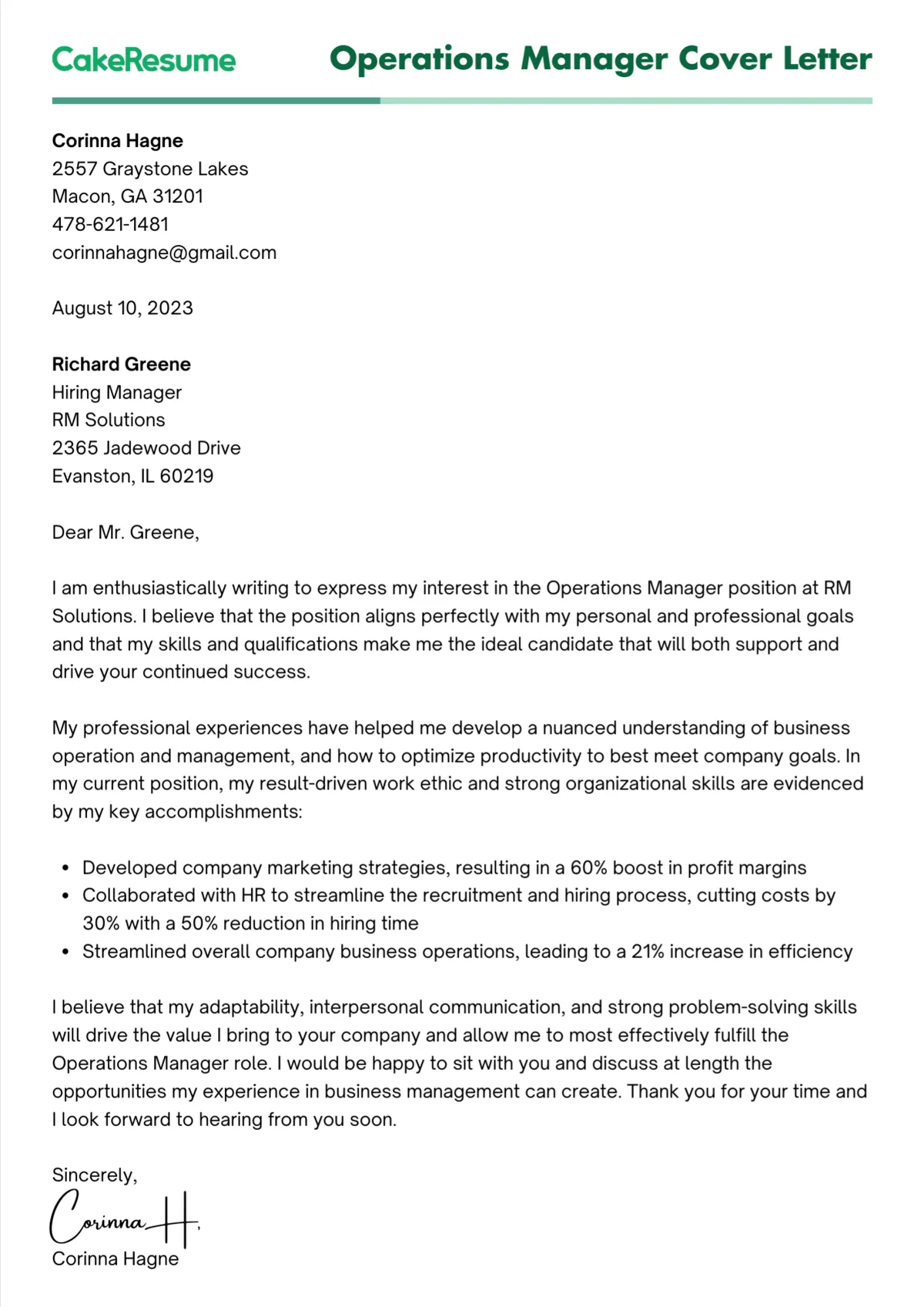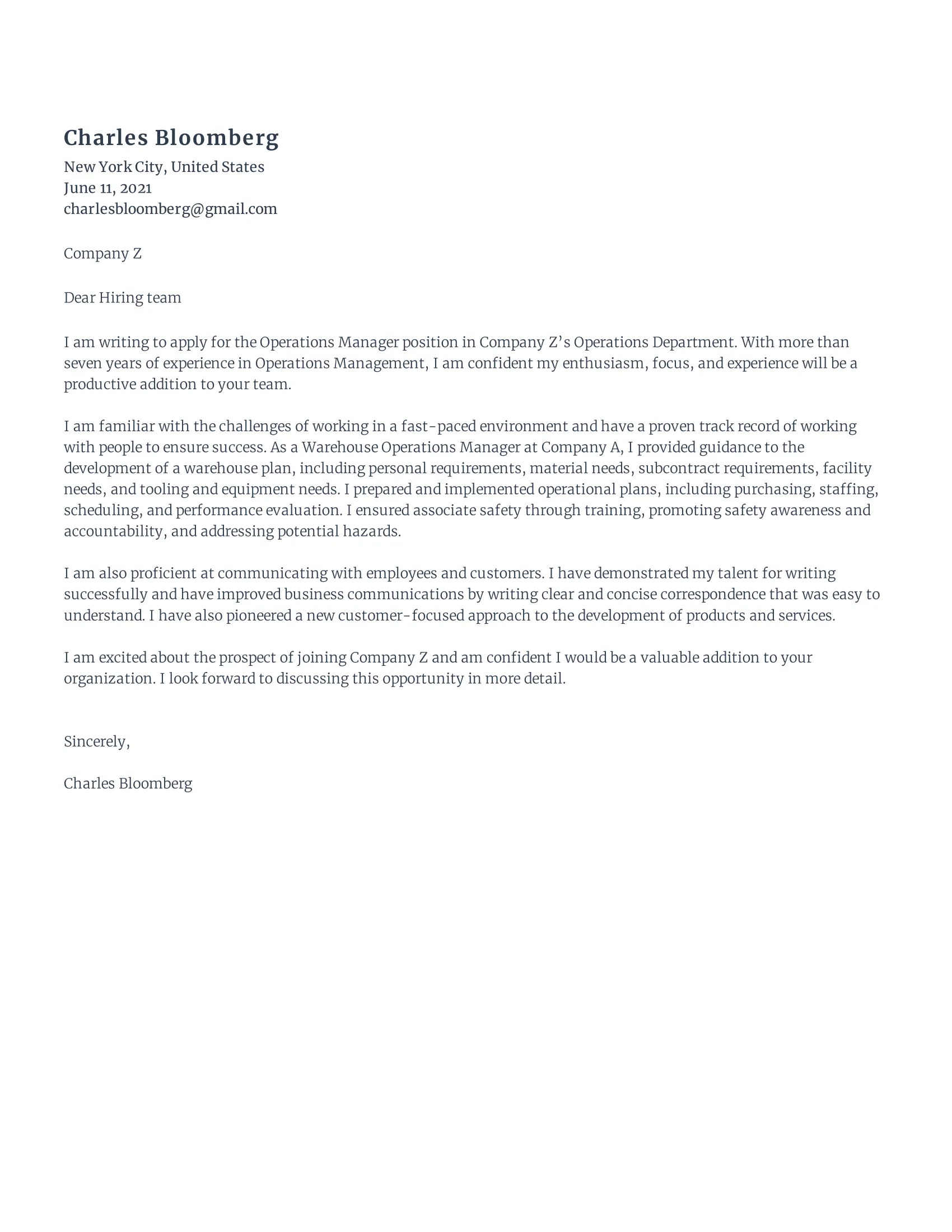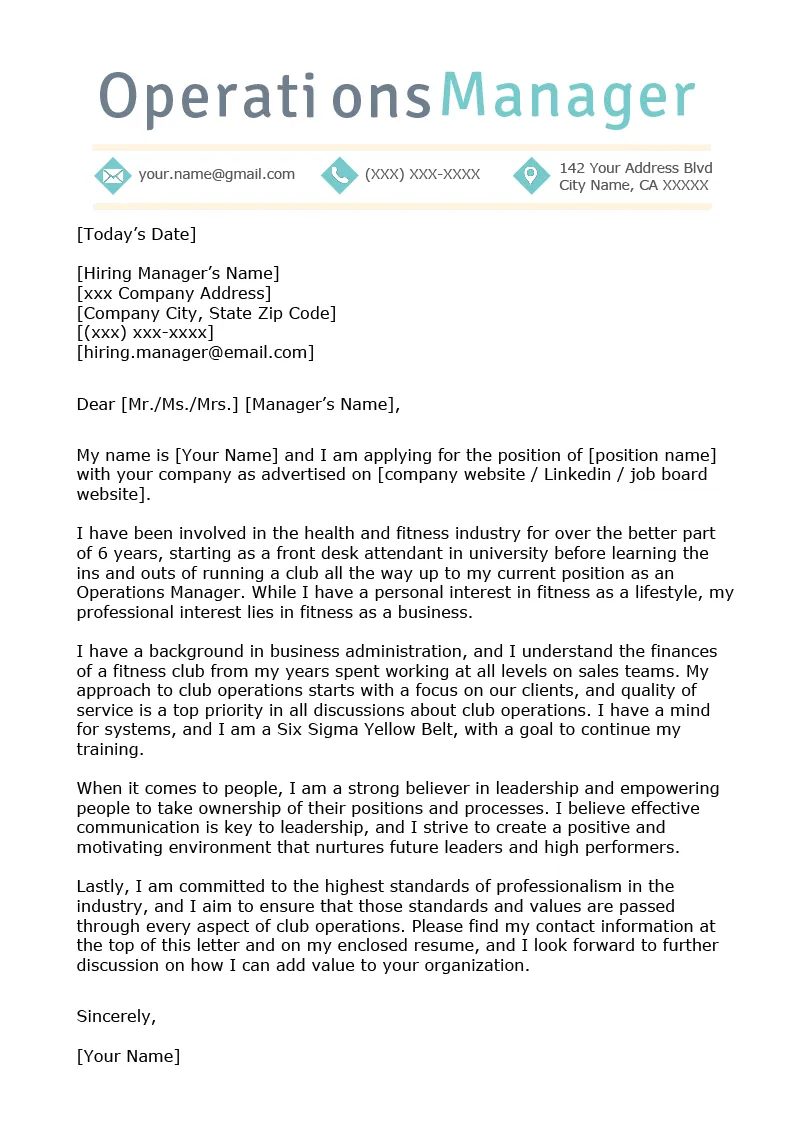Why a Strong Operations Manager Cover Letter Matters
In the competitive landscape of job applications, an exceptional cover letter can be your most valuable asset. For aspiring Operations Managers, a well-crafted cover letter is not merely a formality; it’s a critical tool to distinguish yourself from other candidates. It’s your first opportunity to make a memorable impression, showcasing your skills, experience, and enthusiasm for the role. A compelling cover letter provides context to your resume, allowing you to highlight relevant achievements and tailor your narrative to the specific requirements of the job. This is where you get to paint a picture of how your background perfectly aligns with the company’s needs. A strong cover letter demonstrates your communication skills, attention to detail, and genuine interest in the position, all vital qualities for an Operations Manager. Moreover, it provides a space to articulate your career goals and explain why you’re the ideal candidate for this leadership role.
Key Components of an Effective Cover Letter
To create a winning cover letter, it’s essential to understand its key components. These elements work together to present a concise and compelling narrative. Each section plays a crucial role in conveying your qualifications and capturing the reader’s attention. From the initial greeting to the closing, every word should be carefully chosen to make a lasting impact.
Your Contact Information

Begin with your full name, phone number, email address, and optionally, your LinkedIn profile URL. This ensures the hiring manager can easily contact you.
The Date and Recipient Information
Include the date, the hiring manager’s name (if known), their title, and the company’s address. This demonstrates your attention to detail.
Professional Salutation
Use a professional salutation such as “Dear Mr./Ms./Mx. [Last Name]” or “Dear Hiring Manager.” Avoid generic greetings like “To Whom It May Concern.”
Highlighting Your Skills and Experience

The body of your cover letter is where you make your case. Focus on your relevant skills and experience, demonstrating how they align with the job requirements. This is your opportunity to expand on your resume and provide a deeper understanding of your capabilities. Remember to tailor your letter to each specific job application, highlighting the skills and experiences most relevant to the role. This customization shows that you’ve thoroughly researched the company and understand their needs. Don’t simply list your responsibilities; showcase your accomplishments and their positive impact on previous employers. Use action verbs to describe your achievements, such as “managed,” “improved,” “led,” or “streamlined.”
Showcasing Relevant Achievements
Instead of merely listing your responsibilities, emphasize your achievements and what you accomplished in previous roles. Did you improve efficiency, reduce costs, or increase productivity? Quantify these achievements whenever possible.
Quantify Your Accomplishments
Use numbers and data to support your claims. For example, “Reduced operational costs by 15%” or “Increased team productivity by 20%.” Quantifiable results demonstrate your impact and credibility, making your cover letter more persuasive.
Tailoring Your Cover Letter to the Job

One of the most common mistakes is sending a generic cover letter. Tailoring your letter to each specific job is essential. This shows that you’ve taken the time to understand the company’s needs and the requirements of the role. Customize your letter by addressing the specific skills and experiences mentioned in the job description. Highlight how your background aligns with these requirements and provide examples of your accomplishments that demonstrate your ability to succeed in the role. Use the company’s name and the hiring manager’s name (if available) throughout your letter to personalize it further. This level of detail shows that you’re genuinely interested in the position and not just sending out a mass application. Taking the time to customize your cover letter significantly increases your chances of getting noticed by hiring managers.
Researching the Company
Before writing, research the company. Understand their mission, values, and recent projects. This knowledge helps you tailor your letter and demonstrate your genuine interest.
Matching Skills with Requirements
Carefully review the job description and identify the key skills and qualifications the employer seeks. Then, highlight your relevant experience and skills, providing specific examples of how you’ve demonstrated these in previous roles. Use the same keywords as the job description where appropriate.
Emphasizing Your Passion and Enthusiasm

Express your passion for the operations management field and your enthusiasm for the specific company. This makes your letter more engaging and memorable.
Structuring Your Cover Letter for Impact
The structure of your cover letter is just as important as its content. A well-structured letter is easy to read and allows the hiring manager to quickly grasp your qualifications and enthusiasm. Effective structuring involves clear headings, concise paragraphs, and a logical flow of information. Begin with a compelling opening paragraph, followed by body paragraphs that highlight your skills and achievements. Conclude with a strong call to action, expressing your interest in an interview. Ensure your cover letter is formatted professionally, with consistent fonts, margins, and spacing.
Writing a Compelling Opening Paragraph
Your opening paragraph should immediately grab the reader’s attention. State the position you’re applying for, how you learned about it, and a brief statement of your enthusiasm and key qualifications. Make it clear why you’re interested in the role and the company. Avoid generic openings. Instead, personalize your greeting and quickly highlight your most relevant skills and experiences. This initial impression sets the tone for the rest of your letter and encourages the hiring manager to keep reading.
Crafting Engaging Body Paragraphs

The body paragraphs should provide details of your skills, experience, and accomplishments, aligning them with the job description. Use specific examples to support your claims and demonstrate how you have added value in previous roles. Avoid simply listing your responsibilities; instead, highlight your achievements and quantify your results. Use strong action verbs to describe your accomplishments, such as “managed,” “improved,” “led,” and “streamlined.” Keep each paragraph focused and concise, making it easy for the reader to understand your qualifications quickly. Ensure that each paragraph contributes to the overall narrative of why you’re the best fit for the position. A well-structured body with relevant, impactful details makes your letter more persuasive.
Ending with a Strong Call to Action
Conclude your cover letter with a strong call to action. Express your enthusiasm for the opportunity and reiterate your interest in the role. Clearly state your availability for an interview and thank the hiring manager for their time and consideration. End with a professional closing such as “Sincerely” or “Best regards,” followed by your name and contact information. Make it easy for the hiring manager to take the next step and reach out to you. This final impression is crucial in leaving a positive, memorable impact and encouraging them to consider you further.
Proofreading and Editing Your Cover Letter
Before submitting your cover letter, thoroughly proofread and edit it. Typos, grammatical errors, and formatting inconsistencies can undermine your credibility. Ensure your letter is free of errors and presents you in the best possible light. Pay close attention to the language, clarity, and tone. Read it aloud to catch any awkward phrasing or sentences that don’t flow smoothly. Ask a friend or colleague to review your letter as a fresh pair of eyes can often identify mistakes you might have missed. Proofreading shows your attention to detail and commitment to quality, demonstrating your professionalism. Take the time to review the letter multiple times to guarantee accuracy, precision, and impact.
Common Mistakes to Avoid

Avoiding common mistakes can significantly improve your cover letter’s effectiveness. Many job seekers make errors that can immediately disqualify them from consideration. Recognizing and avoiding these pitfalls ensures your letter presents you in the most favorable light. Here are some of the most common mistakes to avoid, helping you create a cover letter that stands out and grabs the hiring manager’s attention.
Overusing Generic Language
Avoid using generic phrases and clichés that don’t provide any specific information. Instead, use clear, concise language that directly highlights your skills and accomplishments. Generic statements don’t add value and can make your letter sound impersonal. Focus on providing concrete examples that demonstrate your ability to succeed in the role. Tailor your letter to the specific job and company, showing that you’ve done your research and are genuinely interested. Using personalized, specific language makes your letter more engaging and memorable.
Focusing Solely on Responsibilities
Listing your responsibilities is important, but focusing solely on them doesn’t set you apart. Instead, highlight your accomplishments and quantify your results whenever possible. Describe how you improved processes, reduced costs, increased efficiency, or achieved any other significant outcomes in your previous roles. Provide concrete examples that demonstrate your value and impact. This emphasis on achievements demonstrates your skills and showcases the positive impact you can make on the company.
Failing to Tailor Your Letter
Sending a generic cover letter to multiple companies is a surefire way to get your application rejected. Tailor each cover letter to the specific job and company, demonstrating that you’ve taken the time to understand their needs and requirements. Research the company and the role, and highlight how your skills and experience align with the job description. Customize your language to match the company’s tone and values. Tailoring your letter to each application shows your attention to detail, genuine interest, and professionalism. It significantly increases your chances of catching the hiring manager’s attention and progressing in the hiring process.
Sample Cover Letter Example
Creating a sample cover letter helps illustrate the discussed principles in a tangible format. This example serves as a guide, showcasing how to incorporate the strategies and best practices to make your application stand out. The sample provides a clear example of how to effectively structure your cover letter. Remember that this is a template; adapt and personalize this according to your qualifications and the specific job you’re applying for. Tailoring this sample to your needs will maximize your chances of winning the job.
Adapt and Personalize
The key to a successful cover letter is adaptation and personalization. Don’t simply copy and paste a template. Instead, use it as a starting point and tailor it to your experiences, skills, and the specific requirements of the job. Make sure to research the company and demonstrate your understanding of its mission, values, and goals. Highlight how your qualifications align with their needs and show genuine enthusiasm for the opportunity. Proofread your letter carefully for any errors and ensure that the language and tone match the company’s culture. Personalizing your cover letter is what will make your application distinct.
Tips for Sending Your Cover Letter
Beyond writing a compelling cover letter, how you send it is also essential. Here are some tips to ensure your application makes a professional impression. These practical guidelines can influence how your application is received and how it will be perceived.
File Format and Naming Conventions
Always save your cover letter as a PDF file. This format ensures that your formatting remains consistent across different devices and operating systems. Use a clear and professional file name such as “[Your Name] - Operations Manager Cover Letter.” This helps the hiring manager easily identify your application and keeps your documents organized.
Follow-Up Strategies
Following up after submitting your application shows your enthusiasm and persistence. If you haven’t heard back within the timeframe specified in the job posting (or within a week or two if no timeframe is specified), send a polite follow-up email. Briefly reiterate your interest in the role, refer to your cover letter, and mention any new qualifications or updates you might have. Be professional and concise, and avoid appearing pushy. This follow-up demonstrates your strong interest and commitment to the position.
